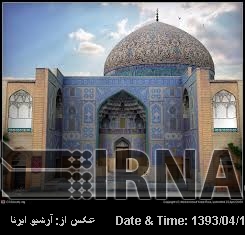Tuesday edition of the English language newspaper Iran Daily wrote that like in most mosques, Iranian architecture has blended with Islamic art to produce a majestic monument.
Seyyed Mohammad Beheshti, the author of a book named “Iranian Mosque the Site of Believers’ Ascension”, attributed the beautiful combination of color and structure in Iranian mosques to the fact that architecture has given importance to spirituality.
Praying is the most important event in a mosque. Its external aspects include performing ablution, facing the Ka’ba in Mecca and forming a congregation.
The most crucial objective of prayer is to make people abstain from sins and be good citizens. Praying sincerely helps Muslims improve their spiritual evolution.
“This is what we see in the architecture of Sheikh Lotfollah Mosque. When we enter the mosques, we understand the sincere purpose of its architecture,” Beheshti said.
All Shia schools of thought value the spiritual aspects of Islam.
Even before the advent of Islam, Iranians gave more credence to spirituality.
Since the early centuries of the advent of Islam in Iran, particularly during Seljuk era, Iranians have manifested their spiritual inclinations through the design and construction of mosques.
“We see this manifestation in Sheikh Lotfollah Mosque and Jame’ Abbasi Mosque (Shah Mosque) in Isfahan,” Beheshti said.
Other mosques were also built in other parts of Iran, which emphasized the spiritual aspects of Iranian architecture. These include Imam Khomeini Mosque in Tehran and Al-Nabi Mosque (Masjed-e Soltani) in Qazvin.
The interior parts of mosques were designed with colorful tiles and stained glass in the Seljuk era, while the exterior parts witnessed colorful designs since Ilkhanid era.
Beheshti said Goharshad Mosque (in Mashhad, northeastern province of Khorasan Razavi) has a colorful exterior that pertains to Timurid era.
“Mosques are manifestations of the highest style of our architecture. Of course, we have magnificent architecture in some bathhouses and houses such as Boroujerdiha House and Ameriha House,” he said.
The author believes viewing these architectures applied in mosques and historical houses refreshes the soul of worshippers and visitors.
The architects of historical mosques were wise and caring men. They made monuments that increased the spiritual feelings of worshippers.
Iranian-Islamic architecture has affected architecture in general, but its direct effect is seldom seen on the construction of special monuments. Except in few cases, such as the effect of Soltanieh Dome (in Zanjan province) on Santa Maria delle Grazie (in Milan, northern Italy).
“Also, if you visit Alhambra’s Islamic Palaces in Granada, Spain, you feel that you are watching an Iranian monument,” he said.
However, after the end of Qajar era, no beautiful mosque was established.
During the rule of the deposed Pahlavi king Reza Shah, the approach toward religion and mosque changed. They considered the main mission of mosque was to bring together Muslims.
“Today, the golden dome is used for mosques, while it was used only in holy shrines. Or currently, we use it in minarets,” he said.
Everybody knows the importance of the first row of worshippers during group prayer (Friday prayer). Therefore, mihrab (the mosque’s altar) should be stretched. This is while, mihrab is built in a corner of some mosques and only two worshippers can pray in the first row.
Most historical Iranian mosques, which observe spiritual aspects of praying, boast a front yard with a pool.
At first glance, many mosques are in blue and azure colors. Mosques and holy shrines became colorful during the Timurid era. This architecture combined colors such as white, black, red, azure blue, azure and green.
The architect uses colors and designs to reflect the tranquility and dignity of the place, such that any worshipper or visitor should feel psychologically calm and spiritually uplifted.
**1420

Tehran, July 7, IRNA -- Visitors to Sheikh Lotfollah Mosque in Isfahan province are awed by its huge dome, Arabesque designs and colorful tiles.

